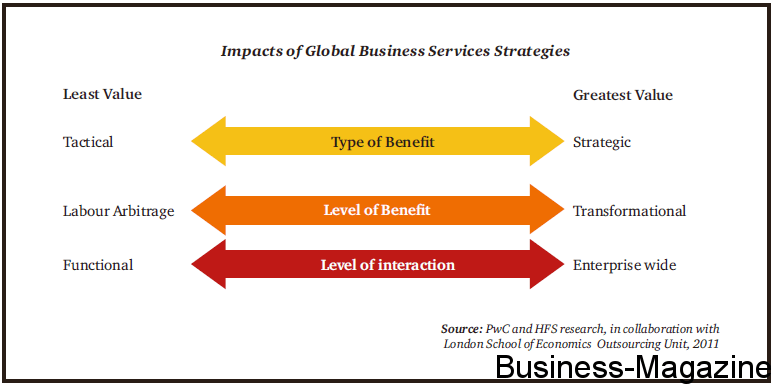The transformational power of Global Business Services Strategies
Share

In last week’s article, we analysed the comparative merits of internal Shared Services, Outsourcing, and Global Business Services. We shall now consider the impact of a well executed Global Business Services (GBS) strategy.
In general, top management can evaluate the level of impact GBS strategies will have on their company based on three criteria:
Type of benefit
This first criterion is the intended type of benefit a GBS strategy will bring to the organisation. The key to success is adopting a collaborative strategy through the integration of internal functions with service provider capabilities. GBS strategies require one to go beyond labour arbitrage in peripheral areas such as finance, HR and IT. The scope of a comprehensive GBS strategy will expand to procurement, supply chain, customer service and operations functions to yield one’s strategic benefits. GBS strategies’ wider focus on broader business objectives requires cross-discipline coordination, and therefore necessitates strong grounding in corporate objectives to drive decision-making.
“For example, one large global software and services organisation woke from decades of rapid growth to an underbelly of administrative functions that hampered its global competitiveness due to a lack of global, standard processes and underinvestment in technologies to support accounts receivable, procurement and HR. The enterprise realised the lack of standards was creating serious compliance issues in Europe and North America, and making its global commercial clients’ lives difficult when handling invoicing and payments. The company partnered with a large outsourcing organisation to make significant investments in technology, and to centralise its functions into regional centers close to its customers.”
Intended level of benefit
The second criterion is the intended level of benefit a GBS strategy will deliver to the organisation. For some enterprises, the historical manner in which they have delivered the same administrative services is sufficient to attain objectives.
Let us consider the case of a large insurance company who wants to reduce the administrative burden attached to mailing out renewal notices, premium notes, remittance advices etc. to its clients. This is typically a low level but essential task, and we have seen many cases whereby this specific function is outsourced. The result is a gain based on labour arbitrage, administrative time saving through a managing a service level agreement as opposed to people, and probably better quality, as this is the core business of the outsourced service provider.
Now, let us assume this insurance company wants transformational value. This could be achieved by selecting an outsource service provider who can interface their systems with those of the insurance company, and has the ability to email attachments to clients in an automated manner. The cost saving would be even more significant, as the time and disbursements spent providing the service would be less, and the clients would benefit from a timelier service.
Level of cross functional interaction (hence synergies)
The third criterion is the level of cross-functional interaction required to drive the necessary results. An HR specific shared services function is likely to require some interaction between itself and IT for a platform, but little other interaction with other functions. A pharmaceutical company attempting to reduce its stock reorder levels would probably consider a shared services strategy that aligns IT, order entry and warehousing/logistics organisations.
Remember, you cannot have a straight jacket approach to GBS strategies, as no organisation’s corporate strategy is the same. As a result, the application of a global business services assessment framework to advance different organisations’ objectives will have different results. For example, an international airline in the Indian Ocean had the strategy to grow its market share by opening up new routes. In doing so, it appointed one airline representation group to grow its point of origin sales, as well as provide local ground handling support. This approach ensured that headcount was kept to a minimum, and the remuneration structure was through commissions based on realised sales. The service provider took care of the local nuances throughout Europe and Russia. The airline further ensured that the service provider had live access to the central reservations system, thus ensuring round the clock agility within a predefined framework and service level agreement. It was a success.
A leading Mauritius textile group decided to expand in the region and invest in Africa. In this venture most of the human resources used were recruited on the Group’s payroll. However, the local compliance requirements and “difficulty” to do business were underestimated. It remained an uphill battle since inception, with the Customs Authorities, Ministry of Employment, Immigrations and the local Municipal Council. Had outsourced providers been used for all the local compliance requirements, working with an internal team providing direction and taking compliance advice, a significant portion of those problems would not have occurred in the first place. This shows that there was no well thought-out global business strategy, but rather an instinctive reaction made to seize an opportunity, hoping that the pieces would somehow fall in place. They didn’t, and the company closed five years after creation.
GBS strategies, of which SS&O plays an integral part, have a transformational power when well executed. But when lightly put together or ignored outright, companies run the risk of paying the ultimate price – that of losing out on their investment.
This is why it is essential to align the objectives of functional leaders within a company and those of their service providers. We share a few practical ways of achieving this in the next article.

















